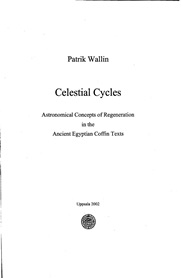
This study analyzes the astronomical references found in the ancient Egyptian Coffin Texts. Chapter i presents the aim and method of this study as well as describing the primary sources and previous research. Chapter 2 deals with the conceptual background for the three cycles, as related to the year, month and the day as units of time. Chapters 3 to 5 discuss the source material and describe how the patterns of movement of the different celestial phenomena were used to describe the regeneration of the deceased as he was incorporated into each of these cycles, thereby enjoying an existence in .cosmic" eternal time. Chapter 6 concludes this study with a summary and conclusion.
The cycle of the year (Chapter 3) is present in the texts in the form of the annual heliacal rising of the star Sirius, deified as the goddess Sothis. This was combined with references to the yearly return of the inundation of the Nile, that occurred at approximately the same time, generating imagery of a yearly rejuvenation. The astronomical features of the Egyptian constellation S3h, approximately equivalent to Orion, were used to complement that of Sothis, and together they represented a celestial version of Isis and Osiris, providing a mythic context for resurrection.
Joining the morrthly cycle (Chapter 4), the deceased was transformed into, and identified with, the moon. The different phases of the moon were used to described stages of regeneration. The deification of the moon as Thoth, and as the Eye of Horus, allowed the deceased to interact with the gods and partake of the powers of the regeneration of the Eye, that culminated at the Full Moon.
The collective appearance of the stars of the northern and southern skies each night provides a background for a daily cycle (Chapter 5). The group of stars called the Imperishable Stars of the northern sky were visible all night, and functioned as an image of an eternal celestial abode. The group of stars called the Unwearying Stars of the southern sky were used to calculate the hours of the night as illustrated by the diagonal star-clocks. The two groups were also identified with the crews of the night and day barks of the sun god, giving the deceased access to the 24-hour journey of the sun, as he joined the daily cycle.
The three temporal cycles of the year, month and day, seen in astronomical phenomena of the night sky, were used to endow the deceased with continual cyclical renewal.

